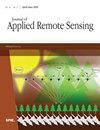Monitoring of land subsidence by combining small baseline subset interferometric synthetic aperture radar and generic atmospheric correction online service in Qingdao City, China
IF 1.4
4区 地球科学
Q4 ENVIRONMENTAL SCIENCES
引用次数: 0
Abstract
Owing to accelerated urbanization, land subsidence has damaged urban infrastructure and impeded sustainable economic and social development in Qingdao City, China. Combining interferometric synthetic aperture radar (InSAR) and generic atmospheric correction online service (GACOS), atmospheric correction has not yet been investigated for land subsidence in Qingdao. A small baseline subset of InSAR (SBAS InSAR), GACOS, and 28 Sentinel-1A images were combined to produce a land subsidence time series from January 2019 to December 2020 for the urban areas of Qingdao, and the spatiotemporal evolution of land subsidence before and after GACOS atmospheric correction was compared, analyzed, and verified using leveling data. Our work demonstrates that the overall surface condition of the Qingdao urban area is stable, and subsidence areas are mainly concentrated in the coastal area of Jiaozhou Bay, northwestern Jimo District, and northern Chengyang District. The GACOS atmospheric correction could reduce the root-mean-square error of the differential interferometric phase. The land subsidence time series after correction was in better agreement with the leveling-monitored results. It is effective to perform GACOS atmospheric correction to improve the accuracy of SBAS InSAR-monitored land subsidence over a large scale and long time series in coastal cities.利用小基线子集干涉合成孔径雷达和通用大气校正在线服务对中国青岛市的地面沉降进行监测
由于城市化进程加快,土地沉降破坏了城市基础设施,阻碍了中国青岛市经济和社会的可持续发展。结合干涉合成孔径雷达(InSAR)和通用大气校正在线服务(GACOS),尚未对青岛的地面沉降进行大气校正研究。我们将 InSAR(SBAS InSAR)、GACOS 和 28 幅 Sentinel-1A 图像的一小部分基线子集组合起来,生成了青岛市区 2019 年 1 月至 2020 年 12 月的地面沉降时间序列,并利用水准测量数据对 GACOS 大气校正前后的地面沉降时空演变进行了比较、分析和验证。研究结果表明,青岛市区地表状况总体稳定,塌陷区主要集中在胶州湾沿岸、即墨区西北部和城阳区北部。GACOS 大气校正可以减小差分干涉相位的均方根误差。校正后的地面沉降时间序列与水准测量结果更加吻合。进行 GACOS 大气校正可以有效提高 SBAS InSAR 监测的沿海城市大尺度、长时间序列的地面沉降精度。
本文章由计算机程序翻译,如有差异,请以英文原文为准。
求助全文
约1分钟内获得全文
求助全文
来源期刊

Journal of Applied Remote Sensing
环境科学-成像科学与照相技术
CiteScore
3.40
自引率
11.80%
发文量
194
审稿时长
3 months
期刊介绍:
The Journal of Applied Remote Sensing is a peer-reviewed journal that optimizes the communication of concepts, information, and progress among the remote sensing community.
 求助内容:
求助内容: 应助结果提醒方式:
应助结果提醒方式:


